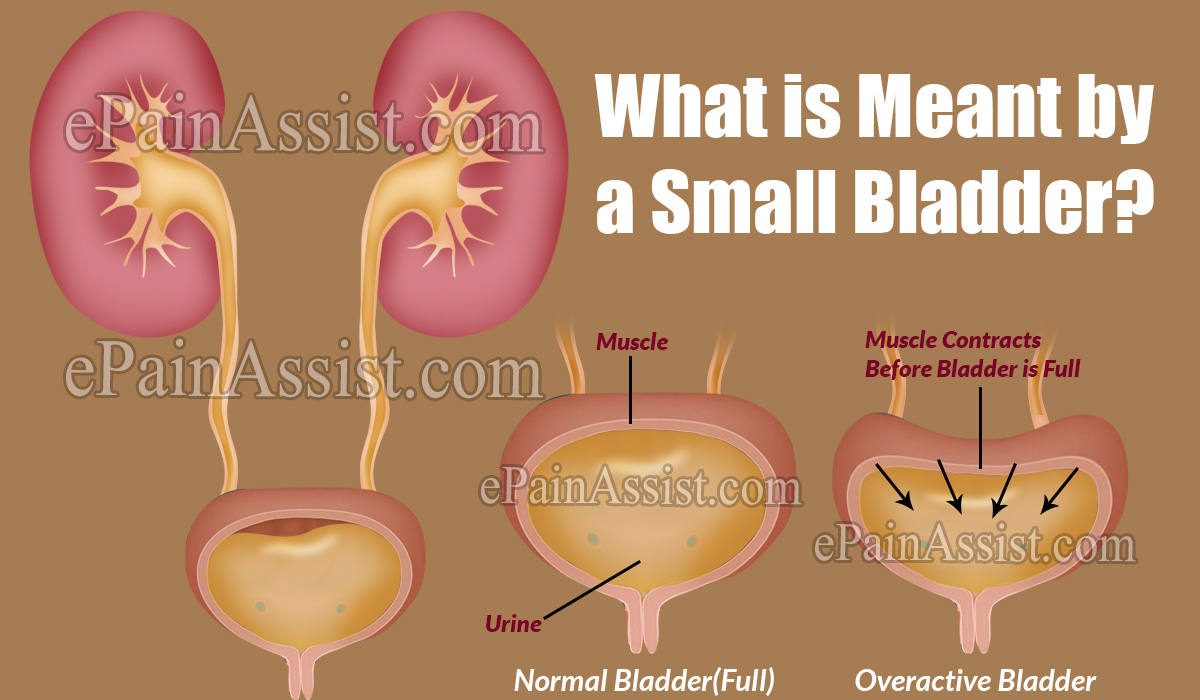Anatomically, it is very much unlikely for anyone to have a small bladder. Internal organs in human beings do not differ from person to person. However, it is possible to have a functionally small bladder, which means that the urinary bladder, for various reasons, cannot hold a lot of urine. The bladder muscles and sphincter muscles become overactive due to which a constant need to void the bladder is experienced. To know more about small bladder, causes, symptoms and treatment, go through the following piece of read.

What is Meant by a Small Bladder?
The condition that results from the sudden and involuntary contraction of the muscle in the wall of the bladder is called overactive bladder. An overactive bladder causes an unstoppable and uncontrollable urge to pass urine and the frequent desire to urinate, both during night and daytime, even when the bladder only contains a small amount of urine. This is known as small bladder problem. Around 15% of adults are affected with this condition, with women being more frequently affected than men. The incidence also rises with age.
What Causes Small Bladder?
The cause of a small bladder has still not been identified accurately. However, some factors are known to contribute to the improper bladder function, involuntary contraction of the bladder muscle, and other symptoms related to an overactive bladder. Certain nervous system abnormalities which cause a small bladder are stroke, dementia, spinal cord injury, multiple sclerosis and Parkinson’s disease. Other causes include trauma to the abdomen or pelvis, nerve damage or trauma resulting from surgery or some therapy, bladder stones, bladder tumour or cancer, urinary tract infection and enlarged prostate. The factors which heighten the risk of small bladder are: Age, gender, obesity, spinal injury, diabetes and pregnancy.
What are the Symptoms of Small Bladder?
The most common symptom of small bladder is the sudden and overwhelming urge to urinate. Increased urge to urinate, nocturia and increased frequency of urination are other signs and symptoms of small bladder.
How is Small Bladder Diagnosed?
To diagnose small bladder syndrome, the doctor would take into consideration all the symptoms associated with an overactive bladder. A pelvic exam for women and a prostate exam for men would need to be conducted to check for any physical signs, which could be causing the small bladder problem. The doctor can also order for some other tests like neurological exam, urinalysis, cough stress test, urodynamic test, and uroflowmetry to diagnose and determine the right treatment option for small bladder.
How is Small Bladder Treated?
Once diagnosed with small bladder, the patient would need to talk to their doctor and determine the most suitable and safest course of treatment to relieve their symptoms. A combination of treatments including lifestyle changes, medications, dietary changes, and surgery can help to effectively manage the problem of small bladder:
Medications for Treating Small Bladder
Some medications like oestrogen, anti-depressants, anticholinergics, and botulinum toxin type A have proven helpful in reducing and alleviating the symptoms related to a small bladder. Since these medications come with the risk of side effects, one should only take them only after consulting a doctor.
Lifestyle Changes for Treating Small Bladder
Bladder training and scheduled voiding are methods used for training the bladder to hold urine over time and also helping to build tolerance to the urgency triggered by an overactive bladder. The patients of small bladder should also practice double voiding, which involves urinating twice within a few minutes in between to empty any residual urine in the bladder. Patients suffering from the problem of small bladder should also practice Kegel exercises regularly for strengthening the muscles of the pelvic floor and urinary sphincter in order to effectively manage urge incontinence in an overactive bladder. It is also very important for individuals with small bladder to maintain a healthy weight and an optimal body mass index (BMI). The process of intermittent catheterisation has also proven very helpful for patients with small bladder. But since this is an invasive procedure, it should only be used in severe cases and as per the recommendation of a doctor.
Dietary Measures to Treat Small Bladder
People with small bladder should also take certain dietary measures, such as eating foods high in fibre, like flaxseed or take fibre supplements. People with small bladder should maintain a schedule of the timing and amount of their daily fluid intake. These individuals should limit their intake of alcohol, caffeine and acidic drinks like cranberry and citrus juices.
What are the Complications from Small Bladder?
Some common complications that can be triggered by a small bladder include dehydration, depression, fatigue, urinary tract infection, bladder stones, dermal infections and irritation, fall and fractures in elderly, decreased productivity, reduced sexual activity, decreased social interaction and reduced quality of life.
Also Read:
- Urinary Bladder Cancer: Types, Symptoms, Stages, Treatment- TUR Surgery, Immunotherapy
- Bladder Pain: Pathophysiology, Etiology, Risk Factors, Signs, Symptoms, Treatment
- Bladder Sphincter Dyssynergia or Neurogenic Detrusor Overactivity: Causes, Symptoms, Treatment
- Urinary Bladder Rupture: Causes, Types, Symptoms, Diagnosis, Treatment
- What is Neurogenic Bladder?
- Bladder Training for Women to Prevent Overactive Bladder and Incontinence
- What is Bladder Pain Syndrome or Interstitial Cystitis: Causes, Symptoms, Diagnosis, Complications
- Urinary Bladder Infection: Symptoms, Causes, Treatment, Prognosis, Prevention, Risk Factors, Diagnosis
- What Causes Feeling of Bladder Fullness After Urination?
